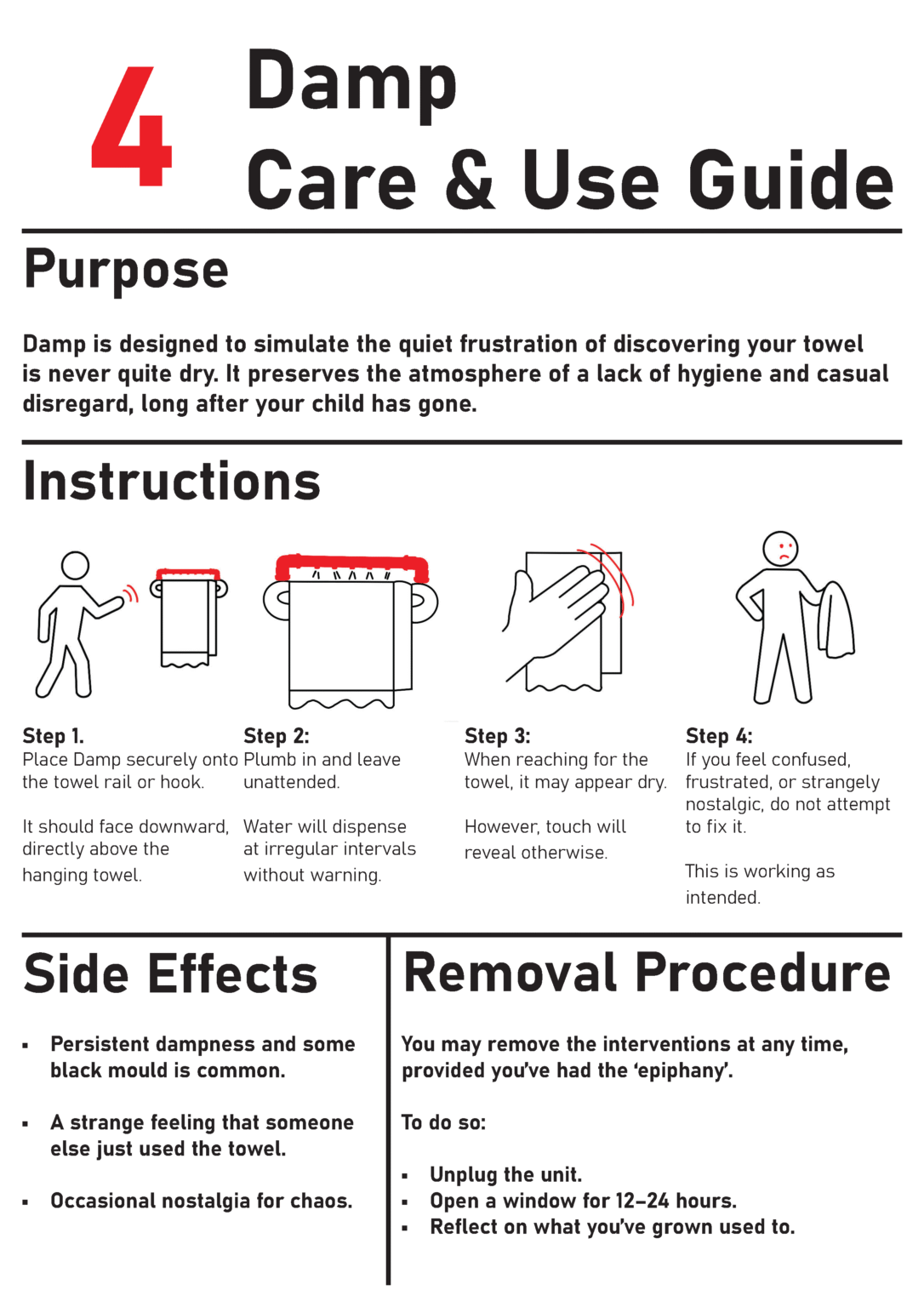Innovation & Technology Product Design
William Wilson

As a designer, I start by exploring how people think, behave, and interact with the world around them. My work aims to challenge assumptions and invite people to see the familiar differently, using design as a way to provoke new understanding.
Works
Collaborative Work

Home Bound
Home Bound is a critical design project that examines the emotional and behavioural tensions caused by delayed transitions into adulthood. It presents a suite of deliberately disruptive domestic artefacts that mimic the lingering presence of a recently moved out child. They are designed to disrupt, recreating the subtle irritations of cohabitation such as flickering lights, towels that remain damp, and voices that will not stop talking, while withholding the emotional reward of the child’s company.
The interventions respond to the erosion of moving out as a meaningful rite of passage. As economic pressures give rise to the boomerang generation, where young adults leave home only to return, the emotional separation once tied to independence is stretched and destabilised.
Although not intended for domestic use, the artefacts offer real value through provocation and reflection. Home Bound invites parents to reconsider what it means to let go, and to recognise that growing up is not always a clean break, for anyone.
What If?
What If?, is designed for individuals with health conditions that can improve through lifestyle changes. Recognising the difficulty of breaking denial and building new habits, this project aims to support and motivate individuals toward change. By creating products that simulate the advanced symptoms of illnesses, such as osteoporosis and emphysema, What If? makes future risks tangible. This empathetic and educational approach helps users confront the potential consequences of inaction. By evoking a sense of urgency through the use of fear as a tool, and equipping individuals with knowledge about their conditions, the project aims to empower them to take control of their health and create a better future.
Compliance or Consequence? // Future Experiences Group Project
Our World
In the year 2035, the NHS operates under strict guidelines that prioritise personal responsibility for health due to severe economic pressures. The government has introduced policies where individuals who neglect their health are denied certain treatments unless they demonstrate efforts to improve their well-being. The public are required to meet basic health maintenance criteria. People are encouraged to track their progress through government issued health services, which monitor physical activity, dietary habits, and regular check-ups. All linked to a national data base that healthcare providers can consult before offering treatment. If an individual consistently fails to follow health advice, their access to non-emergency, medical care may be restricted. This refusal can range from elective surgeries to treatments for chronic conditions that could have been mitigated though lifestyle changes.
The policy has led to a sharp cultural shift. Personal health is now regarded not only as a private matter but also as a civic duty. Those who actively manage their health are praised as responsible citizens, while those who neglect it face social stigma, accused of wasting public resources. Healthcare professionals, while still compassionate are now bound by regulations that push them to prioritise patients who show commitment to their health. In this world, the NHS still offers care, but with a heightened focus on preventative measures and personal responsibility. It’s a system where the burden of care is shared between state, the health care system, and people themselves and where the cost of neglecting personal health may result in being left to cope alone.
Our exhibition takes visitors inside the lives of four individuals living under this policy. Each story based on extensive research and offers a different lens on the reality of life when health becomes a measure of worth. These immersive settings reveal how the policy effects access to care, relationships, employment, and self-perception. You’ll meet:
Eva: After sudden hearing loss, Eva struggled to adapt and connect with others. A referral to a support group left her feeling even more isolated, highlighting how one size fits all care can miss the mark for younger patients like her.
Imran: Working long hours in a high pressure job, Imran’s health has quietly deteriorated. Diagnosed with early onset osteoporosis, he ignores worsening pain. Caught between denial, duty, and a system that demands visible effort before offering care.
Gerald: Once active and energetic, Gerald’s health has declined with a sedentary lifestyle. Now facing limited access to care, he’s motivated to change but stands at the uncertain beginning of a journey where intention must become action.
Amanda: Overwhelmed by work and single motherhood, Amanda’s asthma spirals out of control. A charity funded retreat offers her a rare chance to rest, becoming the breakthrough that helps her reclaim her health for both her and her children.
Each space invites reflect on the line between motivation and coercion, support and surveillance, care and control.
When health becomes a duty, who gets left behind?






















